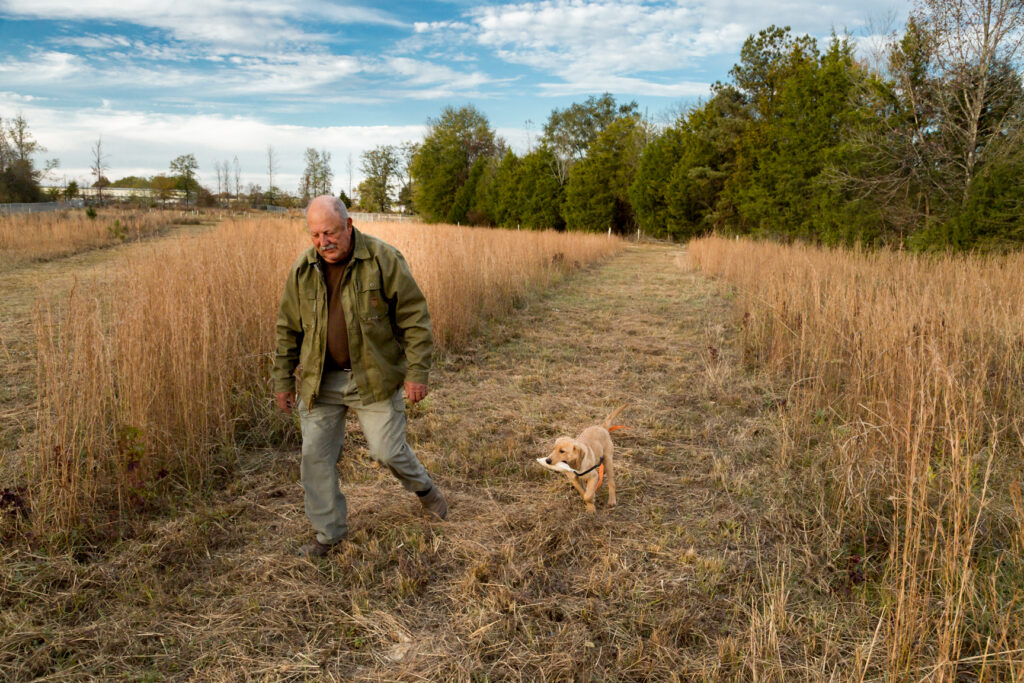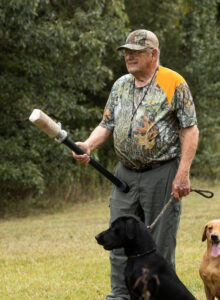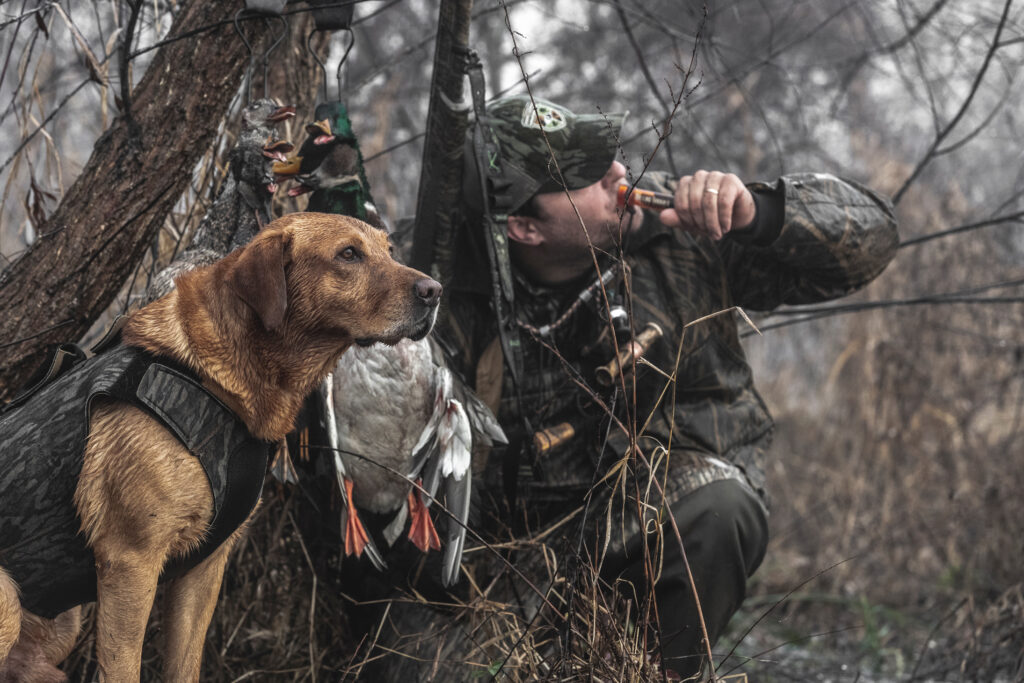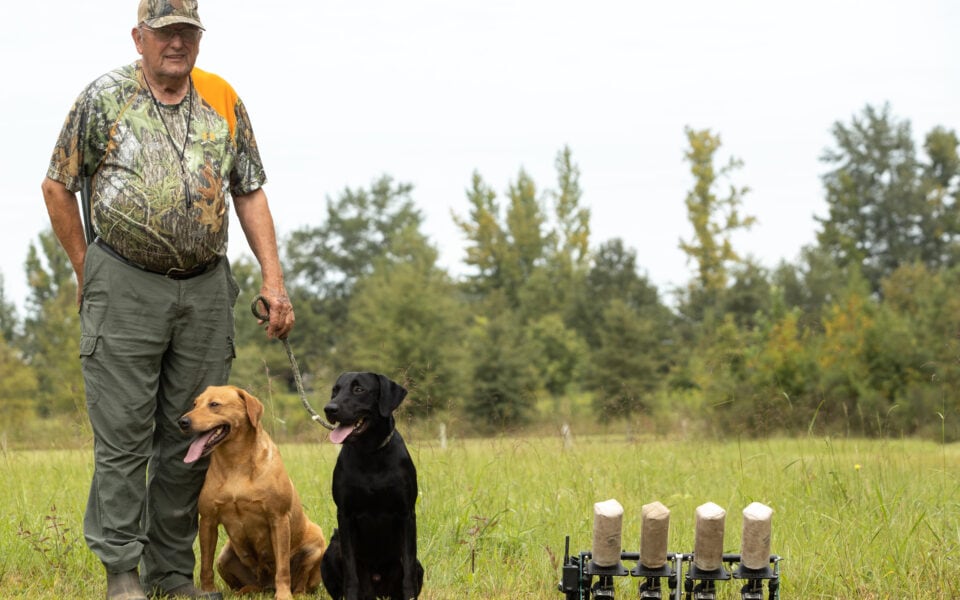I have never seen a puppy that was born gun-shy, but I have seen some that were made gun-shy, primarily by the ill-advised or unknowing actions of the owner – including me when I was a teenager.
Gun Shy Causes
You recently bought a new Labrador retriever puppy and you can’t wait to introduce him to loud noises… so how would you accomplish this feat? What do you do? Do you bang pots and pans while he is eating? No! Who wants to eat a good meal with loud noises clanging around their head? Certainly not I and certainly not the young pup. Do you take him to the gun range with you to get him accustom to gunfire? Absolutely not! How about taking him to a fireworks show? Never, ever – absolutely not! Do you take him on a hunt? No, not until they’re properly introduced to gunfire and well along in his training.
On his first hunt, even though the dog should have been introduced to gunfire by now, do you take him along with all your friends and right from the get-go expose them to multiple gunshots as a flock of ducks is coming into the decoys, or as pheasants flush, or a quail covey rise? No! Why? Because all of these actions lead down the same narrow path – to a dog that has been improperly introduced to gunfire or excessive gunfire and made gun-shy.
There is plenty of time to introduce your pup to gunfire. Why hurry? Remember, that haste in training will likely produce a crack in the training foundation and down the road; it will surely result in a less than desirable outcome. A good example of unwittingly exposing a young dog to a situation that caused him to become gun-shy is presented in the following paragraphs along with the means and methods that we used, in this one instance, to redirect the young dog’s focus on his fear of loud noises to a his reward… a retrieve.
Gun Shy Case Study
We recently received a call from a client the crux of which was that “Hunter,” a puppy that they bought from us, was gun shy. How did they know? She had dropped their seven-month old puppy off with a trainer and a short time later, he told them that they had a really nice young pup, but he was gun-shy and advised that this was a very difficult, if not impossible, problem to fix.
Not knowing what caused the problem, we could only go off of what the client remembered. During our discussion, I explained to her that puppies were not born gun-shy; instead, they are made that way – normally by the actions taken by the owner, either by attending fireworks shows, going to a gun range or shooting guns around the dog before it had been properly introduced to gunfire.
In response to my statement, the client assured me that the dog had not been exposed to fireworks, had not been to a gun range nor had he been shot around. So at this point, I didn’t know what the underlying cause was. I did know that Hunter’s parents were not timid dogs.

We discussed Hunter’s situation further and upon reflecting back on his exposure to loud noises, she stated that she first noticed a problem when she was walking the pup around the neighborhood and was approaching a neighbors’ house where roofers were installing a new roof. She explained that the roofers were using nail guns that emitted a very loud popping noise and when the pup got close to the noise, he sat down and would not go any further. In fact, she finally had to turn and walk the other way, but as soon as they were a good distance away the pup was more or less back to normal. We then knew that the decibel level emitted by the nail guns was the root cause of the problem.
Hunter’s thought processes had become focused on the noise made by the nail guns and we needed to help him unclutter his mind by redirecting his focus from his fear response to loud noises to a reward, which in this case is the retrieve. The conversation ended with me asking her to retrieve the pup from the other trainer and bring it to us for evaluation.
Arrival at Kennel
 A few days later, she brought Hunter to the kennel. We tossed a dummy, released the pup, he retrieved the dummy. We then set up a dummy launcher loaded with .22 blanks, backed up a good 75 yards, hit the transmitter button and launched a dummy toward us. The dummy landed about thirty yards from us and when the dog was cast he just sat there, locked up, looking at us and refused the retrieve. We threw a dummy back toward the launcher and he refused the cast. We moved around and threw a dummy away from the location of the launcher and the dog reluctantly made the retrieve. I assured the client that we could fix the issue and asked her to bring the puppy in around the first of the month so we could start the desensitizing process.
A few days later, she brought Hunter to the kennel. We tossed a dummy, released the pup, he retrieved the dummy. We then set up a dummy launcher loaded with .22 blanks, backed up a good 75 yards, hit the transmitter button and launched a dummy toward us. The dummy landed about thirty yards from us and when the dog was cast he just sat there, locked up, looking at us and refused the retrieve. We threw a dummy back toward the launcher and he refused the cast. We moved around and threw a dummy away from the location of the launcher and the dog reluctantly made the retrieve. I assured the client that we could fix the issue and asked her to bring the puppy in around the first of the month so we could start the desensitizing process.
5 Steps to Correcting a Gun Shy Dog
Step 1: Redirecting Focus
Upon his return to the kennel, we allowed Hunter to acclimate to the kennel for a couple of days before we began the process of redirecting his focus on loud noises to retrieving a tennis ball and/or dummy. After this, for the next two days we would sit the pup in our office and while I held a handheld dummy launcher, let him smell the gunpowder residue on it, then throw a tennis ball, and let him retrieve it. If he broke, there was no scolding or any other type corrections made because our goal was to redirect his thought processes from reacting adversely to loud noises to his ultimate reward – the retrieve.
Step 2: Retrieving Before Firing
We moved on to throwing the tennis ball and dry firing the handheld launcher. At first, Hunter’s body language indicated to us that even the slight noise made by dry firing the launcher elicited a fear response. He would drop his tail, his ears would come back, and he would slink away and would not come near me until I put the launcher down. We continued this routine for a couple of days until this unwanted response was no longer evident.
Step 3: Firing Before Retrieving
Next, we switched to dry firing the launcher, then throwing the tennis ball and letting him retrieve the ball. At first, he would react to the low level sound made by the launcher but, after a few sessions, his body language changed and the noise was no longer eliciting the dreaded fear response. Instead, upon hearing the noise made by the launcher, he started anticipating the throw and concentrating on the tennis ball. We then transitioned from a tennis ball to a training dummy for a few days. After he was picking the dummy, it was clearly time to move on and step it up a notch or two.
Step 4: Focusing on the Dummy
Our next step was to move to our outdoor training area, set up one of our four shooters so that the dummy fired into the freshly mowed field. Why? Because we wanted Hunter to concentrate on the dummy and to accomplish this, he had to see the dummy clearly from the time it launched until it landed in the field. To reduce his exposure to the noise level, the launcher was set up about seventy-five yards from the place where we were stationed. When launched, the dummy would land well away from the launcher and about thirty yards out from Hunter and me.
After the set-up was complete, we put a slip lead on Hunter, got “Diva” one of our finished females out and heeled them both out to the mowed field. Our goal was to amp Hunter up by having him honor the finished dog as she made the retrieves. With Hunter and Diva sitting next to each other on our left side, we launched the first dummy. I observed Hunter’s body language and noted that he did not exhibit any reaction to the noise. He did not flinch, try to move behind me, or hide; instead, he watched the dummy during its entire flight path and appeared to mark it down. I kept him on the slip lead and sent Diva for the retrieve. Upon her return, Hunter’s excitement had ramped-up to the point that he jumped up and tried to take the dummy away from her. Just the reaction I was hoping for – full concentration on the dummy, the retrieve and no reaction to the noise. We successfully redirected his focus from the noise made by the launcher to the flight of the dummy and a potential reward-the retrieve.
Next, we settled Hunter, fired a few more dummies and while Diva made the retrieves; we observed Hunter’s body language, looking for any indication of a fear response. Again, there were no adverse reactions noted. After a reload, we fired another round and still got no adverse reaction from Hunter – he remained calm and concentrated on the dummy. This time we let Hunter make the retrieve and he was ready, he marked well, lined out well, picked the dummy, lined it back and delivered to hand. We continued this drill until all four dummies launched and were successfully retrieved by Hunter. Not to overdo it, we decided to quit for the day on a positive note.
Step 5: Ignoring the Loud Noise
For the next few days, we continued working with Hunter using the same scenario, but after each successful retrieve, we moved closer and closer to the launcher. By the end of the third day, Hunter was sitting right next to the launcher and when it fired, he was so focused on the flight of the dummy that he was oblivious to the noise and was making very nice retrieves. We continued this drill for several weeks and he continued to ignore the loud crack of the launcher.

David McElwain
Conclusion
This is but one successful way to correct a gun-shy issue. There are many other ways to deal with this type issue. The pivotal thing to remember is that you must use a method that will redirect the dog’s thought processes away from the loud noise, to the task at hand, and to the ultimate reward – the retrieve.
A trainer friend in the United Kingdom told me that he uses a treadmill to correct a gun-shy issue. His theory being that the dog concentrates so hard on walking on the treadmill, that it becomes totally focused on the task at hand and completely ignores loud noises-including gunfire. The bottom line here is that some or all methods used may be successful for most dogs, but still one must understand that some dogs, once gun-shy, will never recover.
In this case, we knew the underlying cause – the owner unwittingly exposed their puppy to loud noises made by nail guns. The crack of the nail guns scared the dog and created a fear response that had to be dealt with. Regardless of the source of the problem, it pays to remember that a young pup must be properly introduced to gunfire, and even if properly introduced, exposure to fireworks or multiple gunshots at an early age, even in a hunting situation, can still make a young dog gun-shy. The absolute best way to ensure that you will not have to deal with a gun-shy pup is to use good common sense and not expose a young dog to situations that could cause them to become gun-shy. Remember the old adage that, “an ounce of prevention is worth a pound of cure.” So when engaged with your dog, think about what you are doing and proceed with caution.
Article contributed by Bill Gibson, Director of Gundog Operations and Kennel Master at Mossy Oak GameKeeper Kennels
Join our weekly newsletter or subscribe to GameKeepers Magazine.
Your source for information, equipment, know-how, deals and discounts to help you get the most from every hard-earned moment in the field.









